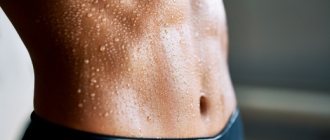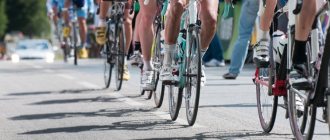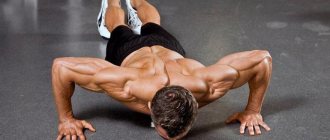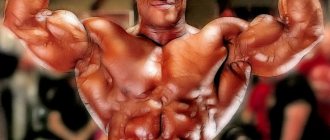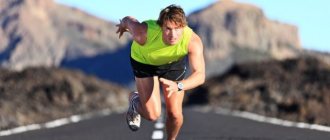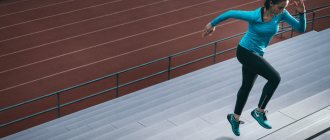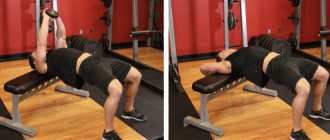Sculpted, strong muscles are not just beautiful. “Building muscle is a preventative measure with which you can avoid the diseases of civilization,” says Andreas Stippler, internist, rehabilitation specialist and author of the best-selling book “Muscles, How Are You?” . “It doesn’t matter whether it’s diabetes, obesity or worn-out joints with damaged discs: strong muscles save the day. I regularly use strength training in therapy. At first, patients are extremely skeptical, but later they are often surprised by its effect.”
How muscles grow
First, let’s explain: from a physiological point of view, muscles do not grow, but increase in volume. This is a complex process that is triggered by a hormonal response to physical activity. Testosterone and somatotropin, growth hormone, play a major role here.
During training, segments of muscle fibers are damaged, the process of restoration of these microtraumas looks like an increase in muscle volume. In order for it to proceed normally (that is, muscle volume constantly increases), several factors are important.
- Having regular strength training.
- Adequate protein intake.
- Increased calorie intake.
- Sufficient time for rest and recovery.
In other words, you won’t be able to pump up voluminous muscles just by “killing yourself” in the gym - the body simply won’t have the resources for this. “You need to remember that training stimulates muscle growth, and this process is based on proper nutrition,” says Valentin Zinin, instructor of SuperPopa group programs at Kometa fitness clubs.
What if you want to remove fat in specific areas?
Separately, it is worth mentioning how to remove fat from specific places. The answer is the same - no way. It doesn’t matter which muscles are working: the stomach, legs or hips. When they need energy, including fat, the endocrine system gives a signal to the fatty tissues. It releases the corresponding hormones - adrenaline, norepinephrine, cortisol. Once they enter the tissue, they instruct the fat cells to give up some of the fat to nourish the muscles.
Photo: unsplash.com/@eugenechystiakov
Hormones are in the blood. Blood is in vessels, capillaries. Capillaries are everywhere. That is, the signal is sent to all adipose tissue at once, to where the capillaries are. In this sense, all subcutaneous adipose tissue is like a single gas tank. Somewhere fat will be broken down faster (face, arms, shoulders), somewhere - slower (buttocks, stomach, thighs). Fat on the sides and thighs of a person, like the humps of a camel, are strategic reserves. This happened in the process of evolution, nothing can be done about it.
Conclusion: eat right, exercise right, get enough sleep, control stress and give up bad habits! Then you can come to any desired shape.
How quickly muscles grow after training
It is believed that the process of repairing damaged fibers begins approximately 2-3 hours after training. This process requires energy and “building material” (proteins), which is why it is recommended to close the “protein-carbohydrate window” after a weight training session. The optimal snack after a fitness lesson is cottage cheese with dried fruits, a turkey sandwich, protein bars, smoothies with cottage cheese and fruits.
The process of muscle recovery lasts approximately 36-48 hours (depending on the muscle group). At this time, it is important not to overload the muscles, sleep enough time, and eat right. The mass of fibers and their cross-sectional area gradually increases. As a result, each individual muscle adapts to the load and begins to work more efficiently - you become more resilient and can handle heavier weights.
How quickly muscles grow from training depends on many factors. “If you do everything correctly, then after about 6-8 weeks of regular exercise you can notice tangible progress,” says Valentin Zinin.
The rate of muscle growth is also affected by training experience. For beginners, in the first six months of training, muscles grow very quickly. “So, a beginner, with proper nutrition and a competent training program, can gain about 2-3 kg of muscle mass in 3-4 months, this is 1-1.5 cm in volume,” says Valentin Zinin.
Over time, the body adapts to the stress, and muscles grow more slowly. However, experts advise focusing not on muscle volume, but on their weight. This parameter can be measured using bioimpedancemetry, an assessment of the qualitative composition of the body. Under ideal conditions, a beginner can gain up to 12 kg of muscle mass per year; on the scales this will look like a “gain” of 15-20 kg. But you shouldn’t chase beautiful numbers - for some asthenic athletes, gaining even 8 kg of muscle per year will be a good result.
Can muscle turn into fat?
Everything is quite simple: muscles are an engine, adipose tissue is a gas tank with fuel. Different organs, different tissues. How to turn one into another? No way.
“Wait,” they will object, “there was once an athlete, a handsome man, with well-developed sculpted muscles. Low fat, fit, athletic. Years passed, the muscles sagged, became flabby, and instead of them there was fat.” Right. The muscles became smaller, and there was more fat on top of them. There is nothing to be surprised about; indeed, muscles atrophy and shrink when not used - they spend less fuel. And if a person eats, as before, in the portions to which he is accustomed, the unspent excess energy replenishes the reserves.
Photo: unsplash.com/@visualsbyroyalz
When they say the muscles are “sagging” or “flabby” - these are just figurative expressions. There are no strings on which the muscles “hang” in order to “sag”. And then there’s nothing to pull them up for. The skin sags under the influence of gravity and the weight of the fat underneath. The appearance of flabby tissue is created. The muscles there, under the saggy folds of fat, are just as toned, only small and weak, and are not visible at all under the layering of tissue.
In order to reverse the situation - to carry out, as they say in fitness, a recomposition of the body - you will have to organize two different, little related processes: reduce the fat component and again try to increase muscle mass. How? There are no secrets here. For muscle growth - training, for reducing fat reserves - eat so much that you constantly lack a little energy for life. The body will have to spend what it has accumulated.
In general, we build muscles in the gym and reduce fat in the kitchen.
What do superheroes eat? Among their favorite foods are not PP dishes
What workouts make muscles grow?
If you are new to a fitness club, you may be able to notice slight muscle growth from almost any workout - be it Pilates or step aerobics. “However, for a stable increase in muscle volume, adequate strength load is needed,” says Valentin Zinin. “That is, requiring approximately 80-90% of your maximum effort.”
The optimal duration of such a lesson is 60-90 minutes. Lighter workouts simply won’t start the process of muscle growth, while more intense workouts will slow it down.
“But muscles do not grow from cardio exercise, but, nevertheless, you should not exclude them from your schedule, they are important for the development of endurance,” adds Valentin Zinin.
A little physiology
Muscle is the most economical part of our body. She tries to lose as little of the substances she needs as possible and, accordingly, gain as much as possible.
Also in the human body there is a mechanism for ideal weight. Your body itself determines for itself the peak at which it should stop when gaining weight, so as not to create problems for itself. If you are not satisfied with this pick, then you need to have a “fight” with it to change the situation.
From birth, every person is genetically endowed with a certain amount of fiber, the quantity of which you cannot increase, but the quality is no problem. Muscle grows by increasing the thickness of the fiber structure. This means that all you have to do is make it (the fiber) grow.
Operating principle
During training, your fibers are partially destroyed (torn), and during rest, the muscle recovers and strives to exceed the limit that was initially set. This process also got its name – “super compensation”.
The process of fiber thickening is accompanied by the synthesis of myofibrils (protein filaments). They absorb nutrients that you eat through food.
The more you train, the more protein threads there will be, the better the blood supply to the muscles. It follows from this that if you do not supply your body with the necessary substances (proteins, calories, minerals, vitamins and much more), then development is out of the question. There is no way your muscles will get bigger, and the fact becomes clear: training without proper nutrition leads to zero effect.
What is muscle fiber hypertrophy?
During exercise, your muscle becomes engorged with blood, which causes it to enlarge, as noted above. This process in bodybuilding is defined by the term “pumping”.
Hypertrophy, in essence, is a disease of your muscle, its non-standard and unusual state. The fiber increases in size due to an increase in the number of myofibrils. The level of protein in the muscle increases.
Testing an Alternative Explanation for the Interference Effect
If the above hypothesis is correct, then the proximity and relative order of aerobic and strength training will influence the interference effect.
Aerobic training performed after strength training should reduce muscle adaptation if the resulting central nervous system fatigue persists until the next strength training session. If aerobic training is carried out immediately before strength training, the interference effect will be stronger; if you perform aerobic exercises immediately after strength training or the next day, you will be weaker.
Indeed, when strength training is performed before aerobic training, the interference effect is small, even in well-trained athletes. According to the literature, the interference effect is greater when aerobic exercise is performed immediately before strength training, compared to aerobic exercise performed immediately after strength training.
If the hypothesis is correct, we would expect the interference effect to have a greater impact on measures such as maximal strength and power than on muscle size. Indeed, literature data confirm this. This is because the ability to recruit motor units is an adaptation to long-term strength training, and this adaptation allows for increases in maximum strength and power. Failure to recruit all motor units during exercise means those muscle fibers are not trained and strength does not increase.
What are the practical implications?
We still know little about how long central nervous system fatigue lasts after different types of exercise, although fatigue is greater after longer exercise.
We also know little about which types of exercise cause severe central nervous system fatigue and which cause milder central nervous system fatigue, although muscle damage is known to aggravate this fatigue even when training lasts only a short time.
Practically, this means that if we want to include aerobic exercises in a strength training program, they should not be performed immediately after strength exercises, they should not be done for long periods of time, and exercises that often injure the muscles, such as running, should be avoided.
Diet Basics
For some reason, many beginners mistakenly believe that in order to grow muscles, you need to eat almost nothing but meat.
This is not true. Some famous bodybuilders have become famous not only for their huge muscles, but also for the fact that they do not consume meat products at all. They satisfy the body's need for proteins with milk and dairy products, legumes and nuts. This does not mean that all athletes should become vegetarians. If there is no prejudice against meat foods, then beef, poultry and fish must be present on the table every day.
It must be remembered that the body is not able to absorb more than 30-35 grams of protein in one meal. Therefore, you should not overload your stomach. All the same, all the excess will not be absorbed and will be eliminated from the body.
A bodybuilder should consume 3500-4000 kcal per day. During intense training - up to 7000 kcal.
In addition to eating meat, a jock should eat vegetables and fruits every day. Along with them, the daily diet should include foods containing vegetable fats. For example, nuts.
No matter how well a bodybuilder eats, he must take multivitamins and microelements in tablets.
Try to eat as varied as possible. Learn to cook and cook for yourself. You should eat at least three times a day. Ideally, you need to eat 5-6 times a day, but in small portions so as not to overload the stomach. Instead of coffee and tea, drink mineral water.
Avoid the following foods:
- flour and fried foods, sweet dishes;
- animal fats (eat lean meat or meat with trimmed fat);
- completely eliminate alcohol;
- do not eat spicy or overly salty foods.
Sample diet for a novice bodybuilder
Breakfast:
- 3 egg omelette;
- boiled fish fillet with a side dish (potatoes, buckwheat or rice);
- bread;
- fruit (orange, piece of melon, apple);
- a glass of skim milk.
Lunch:
- nuts, seeds or a slice of cooked meat on a sandwich;
- kefir or yogurt.
Dinner:
- fish, meat or poultry with vegetables;
- green salad;
- fruit;
- a glass of skim milk.
Before training:
- 2-3 different fruits to accumulate energy.
After training:
- meat, fish or poultry with vegetables;
- green salad;
- a glass of skim milk.
Dinner:
- cheese;
- fruit;
- a glass of skim milk.
Persons suffering from milk intolerance can replace it with juice or mineral water.
Milk has a good effect on muscle growth, but you should not drink it by force. There will be no benefit from this. You can optionally add potatoes and various cereals to this diet.
Why is the time between reps important?
When muscles constantly contract and relax, blood accumulates in the muscles. This leads to cellular edema, in which the muscles become visually larger. Many people call this process pumping.
Pumping, in turn, leads to a restriction of blood flow in the muscle. As a result, the muscle experiences a lack of oxygenated blood during continuous contractions.
This leads to the accumulation of metabolites in the muscles. The resulting metabolic stress on muscles has an anabolic effect (promotes muscle building), which leads to molecular signaling and increased hormonal responses in the body that cause hypertrophy.
Occlusion training itself (restricting blood flow to the muscle being trained) can be used to induce hypertrophy and maintain muscle mass. This uses much lighter loads and increases the number of repetitions performed.2
To train occlusion, cuffs, elastic bands, and tourniquets are used, with the help of which the venous outflow of blood in the trained muscles is artificially limited. Also, using a light weight (something you have on hand, say a one-pound pack of sugar) for high reps can help you achieve a similar effect.
And the final conclusion
Combining aerobic exercise with strength training slows muscle growth. Although the accepted explanation for this effect is that signaling molecules produced after endurance exercise suppress the effects of anabolic signals, Chris Beardsley considers his own theory more plausible, according to which aerobic exercise causes fatigue in the central nervous system, which in turn reduces number of motor units recruited during subsequent strength training.
Source:
Sports nutrition
Nowadays, many stores offer nutrition specifically designed for bodybuilders. It is a mixture of dry proteins, carbohydrates, microelements, vitamins and everything that a bodybuilder needs.
Despite what the manufacturers of such products, the press, advertising and media may claim, there is no need for an amateur bodybuilder to use them constantly. Taking sports nutrition as a “feeding supplement” begins when the bodybuilder can no longer gain muscle mass with regular nutrition. They will make muscles grow.
Sports nutrition is used on an ongoing basis only to solve specific training problems. For example, before a competition, when an athlete is on a strict diet in order to get rid of subcutaneous fat. During this period, he is forced to reduce the consumption of conventional foods to a minimum, while simultaneously carrying out heavy training. This is where mixtures and nutritional supplements come to the rescue, containing everything a bodybuilder needs, except fats.
Proper nutrition
Any professional bodybuilder will confirm that the difference between amateur and professional bodybuilding is knowledge of nutrition. The importance of nutrition in professional sports is much more complex than it seems at first glance.
For example, an athlete decides to train more intensely. To do this, he needs to increase the proportion of carbohydrates in his diet. An ignorant person will decide that he needs to eat more sweets. But sweet dishes will worsen digestion and protein metabolism will slow down. And in order to build muscle, you need fast protein metabolism. In addition, sweets contain a large amount of fat, and a bodybuilder does not need them at all.
With all this, intense training is completely impossible without increased carbohydrate nutrition. Experienced athletes have long known that not only sweets can be used as a source of carbohydrates. Using their knowledge of nutrition, they select a diet that meets their goals. It also happens that nutrition programs aimed at muscle growth are completely vegetarian. It’s incredible, but it’s a fact that many holders of the Mr. Olympia and Mr. Universe titles have never consumed meat products at all.
The basic rules for eating are as follows:
- Listen to your body. It often happens that a personal eating schedule does not correspond to the generally accepted one. In this case, the bodybuilder will have to be creative and make the diet the way the body requires. For example, some start the day with a hearty breakfast, while others cannot bear food at all in the morning. But even if an athlete finds an optimal nutrition plan for himself, over time the metabolic processes in the body may change. Therefore, you need to constantly listen to your stomach and follow its wishes.
- Don't overeat, even if it seems like your workouts are too hard and take a lot of energy. The body can only absorb a limited amount of protein in one meal. Considering that food is not cheap, overeating can only lead to excrement becoming the most expensive in the area
- Three meals a day are usually not suitable for a bodybuilder. For muscle growth, it is healthier to eat 4-6 times a day. By the way, many nutritionists advise ordinary people to eat according to this scheme.
- Don't try to eat only meat. Even the biggest lovers of meat products sooner or later switch to a vegetable diet. On the other hand, a large amount of vegetables will have a healing effect on the liver and stomach and reduce cholesterol levels in the blood.
- Become a nutrition expert. To do this, it is enough to read several popular books on dietetics and always have a reference book on hand indicating the amount of proteins, fats, carbohydrates and other substances in various products.
2.What are the symptoms of a muscle tear?
Violation of the anatomical integrity of muscle fibers causes severe pain and an attempt to adopt a forced, gentle body position, in which the affected muscles are least stretched. Often the rupture causes convulsions that cannot be relieved for a long time. If the skin at the site of injury is not damaged, intense internal hemorrhage begins, which causes swelling and redness. The resulting hematoma may appear after some time in the form of an extensive bruise.
Motor activity in the affected area becomes impossible due to severe pain with any attempt to move. If the muscle bundle is completely torn, certain movements are simply impossible. With a partial rupture, the function is preserved, but the acute pain syndrome forces the victim to remain completely at rest.
Diagnosis of this injury is not difficult. The symptoms are obvious and pronounced. It may just be necessary to differentiate trauma from more severe disorders. If it is necessary to exclude a fracture, an x-ray examination is prescribed.
Visit our Traumatology and Orthopedics page
Changing the diet
If you ask an experienced trainer how to gain weight at home, the answer will be the same - start eating right. We focus on increasing the number of incoming calories and balance. Everything is individual here - for some, a 15% increase in calories is enough, for others, others will have to increase the amount of calories by one and a half to two times.
Here are general tips for improving your nutrition system:
- Consume more protein foods. Focus on poultry, seafood, fish, and nuts. It is important that the food consumed contains as little saturated refractory (animal origin) and trans fats (fast food, baked goods - everything made with margarine) as possible. But there should be more unsaturated fats. To do this, include olive, rapeseed, and peanut oil in your diet.
- A good choice would be legumes - beans, chickpeas. Lentils suit many people. But we don’t recommend relying on soy, especially for women. Boiled eggs also help with weight gain—pros eat at least six of them a day.
- Don't forget complex carbohydrates. Various porridges are perfect for lean meat - from rice and buckwheat to corn and pearl barley. Add black bread, pasta, vegetables (preferably without starch) to your diet. Athletes also need fruits, but only if they are low in sugar.
- Always watch your calories. It is better to keep a table in which you write down how much you consume and spend every day.
- Set up a weight control routine. Every five days you need to step on the scale and mark the values. If muscle mass increases by less than 700 grams, more calories are needed. If it is significantly more than 700 grams, the calorie content should be reduced.
An important aspect in gaining weight is the frequency of nutrition. We recommend splitting your meals into five to six times, that is, eating in smaller portions, but more often.
